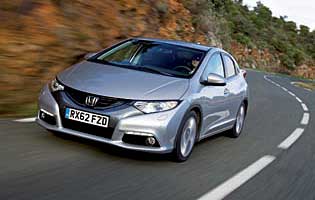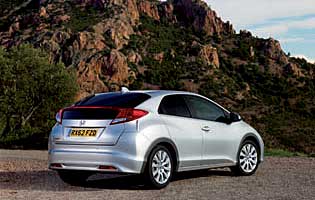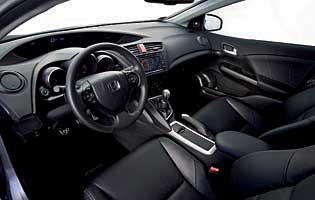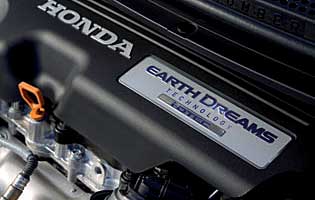



Overall rating

Elements of the original design remain





There's no question that Honda's decision to radically change the looks of its Civic has polarised opinion. The need to reach out to more youthful buyers is always important to secure a long term future. However, there's also the need to ensure you don't spook existing customers. In some quarters the jury's still out, but there's no denying that Honda's engineering talents remain strong – witness a super-clean and frugal 1.6-litre diesel engine.
More of an evolutionary change to a previously revolutionary design shift, this generation of Civic's appearance has been softened slightly to strike a more sensible balance to please new and existing customers alike. It remains a core model for Honda, and as such, the arrival of the long-awaited 1.6-litre diesel unit promises to save motorists money and increase its appeal in the lucrative company car market.
Recent years have seen the Civic become a little more willing in its demeanour, with the gap between it and Toyota's Corolla – universally accepted to be the least sporting of the Far Eastern hatchbacks – widening. The iteration goes a step further in its desire to please keen drivers, but at its original launch critics weren't completely convinced. The lighter 1.6-litre diesel goes a long way to fixing this, and the car's agility is noticeably enhanced due to the reduced weight in the nose and the unit's more flexible power delivery.
The car's newfound driver involvement, at least in 1.6 diesel guise, is matched by the car's high quality cabin. Like before, the ambience matches that of its German rivals, although on closer examination the ergonomics – switchgear and instrumentation – could be more intuitive and are probably a little too radical for some but the driver-focused layout is rare in the family hatch sector.
The family hatch market is a fierce one and the need to broaden the Civic's appeal is important for the company's future. And it's difficult to deny the fact that swooping curves, a rakish nose, Alfa-style rear door handles, a Star Trek-like dashboard and digital instruments will appeal more to the PlayStation generation than any other.
An evolution of the original rakish Civic, this version has toned down that car's 'spaceship' looks a little. It remains a competent contender though, thanks to Honda's core durability and high build quality attributes. In the face of fierce competition, there's no question that the arrival of the 1.6-litre diesel engine is a much needed one. Offering meaningful running cost savings and a useful boost to the driving experience, it's given the Civic a much needed boost.
Standard equipment levels are reasonably high and the amount of safety kit is generous even on entry-level models. Flagship models are particularly well equipped, too. The cash premium for a diesel variant is worth acknowledging, although the potential savings are worth investigating – especially with in the case of the sub-100g/km CO2 1.6-litre oil-burner. Other running costs are unlikely to break the bank – Hondas are noted for their reliability, making visits to the dealership rare.
Since launch the Civic has been acknowledged for possessing a spacious cabin and boot. Oddment space is reasonable thanks in part to a generously proportioned centre console and glove box. The same is true of the boot, which is both deep and wide and boasts a clever hidden compartment where you'd normally find the spare wheel. Folding flat the rear seats is a convenient one-handed job, with the 'Magic Seat' option of folding them up out of the way to liberate more space behind the front seats a clever trick.
If you're a fan of digital instruments you'll warm to the Civic's offerings. For everyone else it's an acquired taste. Also, from an ergonomic angle, it makes a lot of sense to group the various dials and controls together and within reach of the driver. However, the front seat passenger will have to stretch to reach the ventilation controls as the design is obviously driver-centric.
Occupants benefit from decent levels of head and legroom. Rear seat passengers are treated in a similar manner, with no major comfort niggles to report. At urban speeds the cabin does well to insulate occupants from road and engine noise. The Civic boasts a pleasingly supple ride, while buyers choosing the 1.6 diesel variant benefit from reduced cabin and engine noise over the older 2.2 unit.
It might 'only' be a family car, but the Civic isn't short of security features. An immobiliser, deadlocks, remote central locking and are standard across the range. For added peace of mind it might be worth investing in a steering lock as a visible deterrent to compliment the car's rear privacy glass.
As with the so many cars in this class, twin front and side airbags come standard on the Civic range along with anti lock brakes, electronic stability control and brake assist. Isofix child seat mounting points are also present, along with five, three-point seat belts.
This Civic variant promises a clever blend of refinement and driving ability that should please both conservative and keen drivers respectively. Boosting the car's appeal is the 120 horsepower, 1.6-litre diesel engine – a long awaited development. Aside form tax and wallet-friendly emissions and fuel economy, the engine's low weight is noticeable during turn-in, improving the car's agility. It's also a quieter unit than the older 2.2 engine. And as with other Civics, the car's manual gearshift is precise and the brakes powerful but easy to modulate.
Unlike an MPV the car's seating arrangement is fixed, but cabin space is good and the boot is equally generous. Isofix child seat anchor points are present. If bought as the only car in the family, the Civic is also presentable enough to be used for business related chores during the week. The 'Magic Seat' option is also worth having as you won't find it elsewhere in the market.
The Civic is easy to drive, making it a sensible option for the novice driver. The entry level 1.4 petrol variant would be ideal for first timers, as the larger 1.8 petrol and diesel variants are no slouches and would probably cost a bit more to insure.
Panels gaps are tiny, fit and finish is exemplary and the choice of materials used to trim the cabin is well above the class average. If the performance of past Civics is anything to go by, mechanical reliability should also be first rate. This car's exterior is a mechanism for Honda to chase a younger audience, as the firm long-standing image is one that attracts the more mature buyer. Factor in the long awaited inclusion of a low CO2 emitting diesel and company car drivers should also find this Civic attractive.
The combination of a slightly elevated front seat position, doors that open wide plus reasonable headroom both fore and aft all make this Civic an easy car to live with. Access to the rear seats is also good, although it's easier to get in than get out. The tailgate opens nice and wide and requires little effort to do so.
Standard fit is a combined radio and single CD unit, with remote audio controls conveniently located on the steering wheel on selected models. The display is on the large size and sound quality is good from the standard unit, while notable options include Bluetooth and a DVD-based sat-nav unit are available as standard on high-end models. The latter comes with a big screen although its appearance doesn't quite gel with the look of the cabin and it could be more intuitive to operate.
Lighter hues do much to draw attention to the car's various lines and curves so chose carefully. The cabin look and feel is more than ever like an Audi. The generous use of high quality black plastic is impressive but there's a lot of it. The standard cloth seats are nice, although the optional leather chairs add a more premium feel but aren't quite as supportive.
Forward visibility is good, thanks in part to the slightly raised driving position. Rearward vision remains an issue, however. It might look good from the outside. The tailgate's design includes a split window which doesn't help matters. Thankfully the car's side mirrors are a generous size, and go some way to compensating for the restricted rear view. As do the parking sensors where fitted.
Tyre mobility kit supplied as standard.
Petrol engine options: 1.4 (100bhp); 1.8 (142bhp). Diesel engine options: 1.6 (120bhp); 2.2 (150bhp). Transmission options: six-speed manual transmission across the range with a 5-speed auto optional for 1.8 petrol variant. Trim levels: SE, SE-T, ES, ES-T, EX, EX GT.